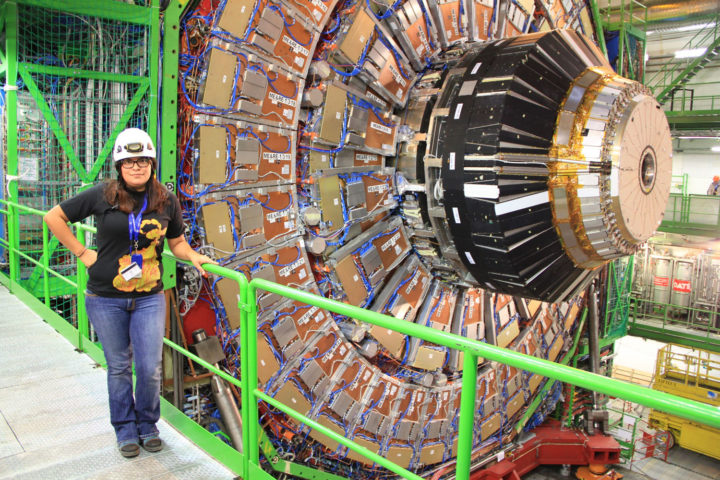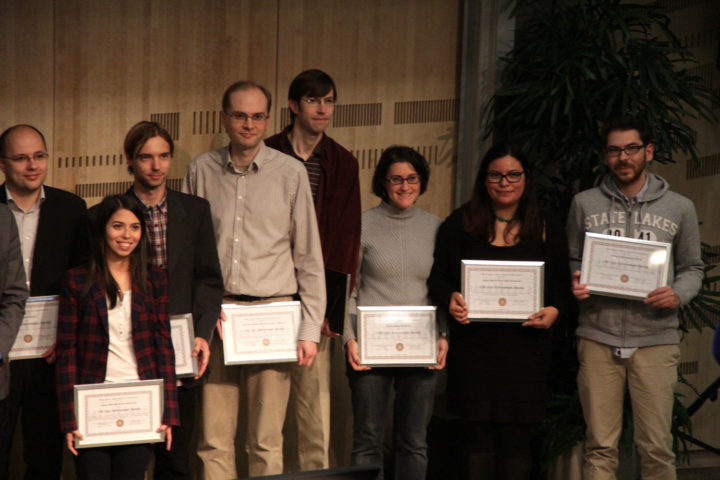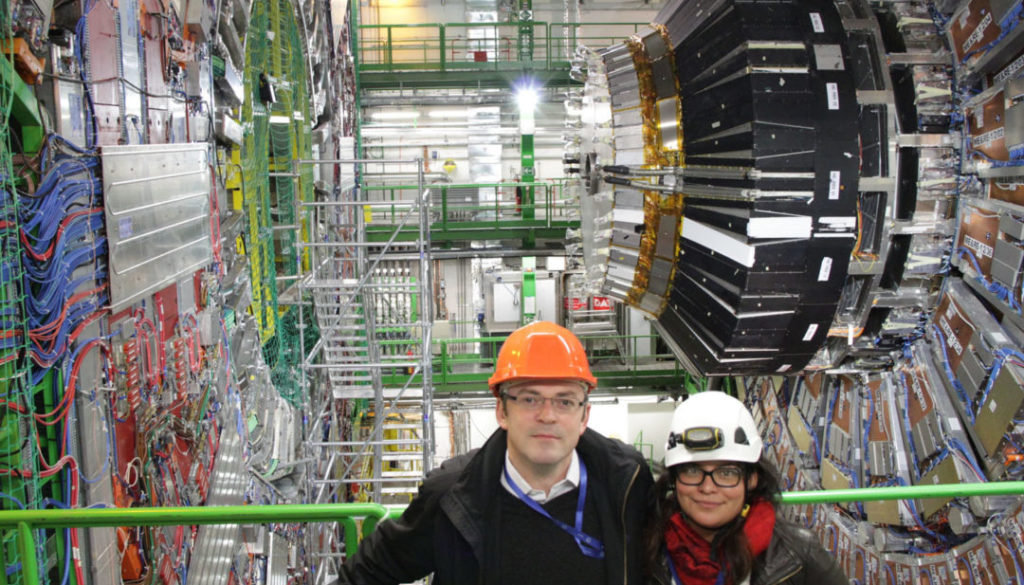Texas A&M Physics Student Finds Niche in Collider Research at CERN
Indara Suarez didn’t speak a word of English when she arrived to the U.S. from Mexico at age 12. The grades she made in high school weren’t good enough to get her into a four-year university.
Now as a doctoral student at Texas A&M University working toward a Ph.D. in high-energy physics, Suarez has received a coveted award recognizing outstanding contributions on one of the world’s biggest stages for elite particle physics — CERN, or the European Organization for Nuclear Research.
“In Mexico, I was used to being known as ‘the smart kid,’” Suarez said from Switzerland in her office at CERN. “So the language barrier was very draining for me, and I struggled. But a lot of people helped me, believed in me and supported me. I wouldn’t be here without them.”
On Monday (Dec. 9), Suarez was honored with a 2013 CMS Achievement Award, given to 23 of the roughly 3,000 scientists from around the world working on the CMS, or Compact Muon Solenoid experiment, which is powered by one of two large particle physics detectors at CERN’s Large Hadron Collider. The award was given for her work integrating panels developed at Texas A&M and other universities as part of an upgrade to the system.


Designing a better data filter
The optical trigger mother boards (OTMBs), built in the George P. and Cynthia Woods Mitchell Institute for Fundamental Physics and Astronomy-located laboratory of Texas A&M physicist and CMS collaborator Alexei Safonov, serve as part of the detector’s data filtration system. Scientists collide protons into each other at nearly the speed of light with the hope of observing interesting physics events, such as a new particle like the Higgs boson. The collisions occur about a billion times per second, and the boards help decide which data to discard and which to store.
“Imagine CMS as like a camera,” said Suarez, who is deputy leader for system integration and commissioning for the muon endcap electronics upgrade. “There’s a limitation to how many pictures can be stored because you have limited memory in the camera. You can’t store all your pictures, so you have to choose which to store. It’s kind of the same thing. All of the data we collect has to pass the first filter, and our board is the one that makes that first decision. The physics that we can do depends a lot on this system.”
The upgrade is only part of Suarez’s job at CERN as Texas A&M’s only current resident representative. Suarez, a National Science Foundation fellow, plays a key role on the CMS Fundamental Physics Scholars Committee. In addition, she has become a tour guide for the CMS experiment and even taught a group of grade-school girls how to make a “salad bowl accelerator” a few weeks ago as part of the Expanding Your Horizons event in Geneva. One of her favorite parts of the job is mentoring undergraduates from Texas A&M and universities around the world during their stays at CERN.
In addition to accepting her CMS Achievement Award last Monday, Suarez got to announce Joosep Pata as the 2014 recipient of a prestigious scholarship that provides 20,000 francs (about $22,500) for a young researcher to come to CERN for a year. The scholarship is funded through the $3 million Fundamental Physics Prize — the most lucrative award in physics — shared in part by CMS experiment spokesperson Joseph Incandela for work that led to the discovery of the Higgs boson. Pata, a master’s student from the Estonian National Institute of Chemical Physics and Biophysics, was one of 51 applicants from 19 countries.
“As a doctoral student, I find working with other students incredibly rewarding,” Suarez said. “To see them evolve is very important to me. I myself went through some of the programs they’re going through. So anytime I get the chance to work with students, I say ‘absolutely.’”
Making the grade
Following graduation from John Marshall High School in Los Angeles, Suarez attended a community college, Pasadena City College, because her grades weren’t good enough to get into a four-year university. Since her arrival in the U.S., she had struggled in most of her classes, with the exception of mathematics — a subject area in which she could still see herself as “the smart kid” because there was no language barrier with numbers.
After enrolling at Pasadena City College with the goal of becoming a math teacher, Suarez had a transformative experience through a Research Experience for Undergraduates (REU) program at nearby University of California at Santa Barbara, where she conducted condensed matter research and realized her career passion.
Suarez began applying for all the internships and summer research opportunities she could find, eventually boosting her grades and gaining enough experience to be accepted to the University of California at Los Angeles’ physics program. She then did a post-bachelor’s fellowship, working frequently from Germany on a nuclear physics project, and eventually decided on Texas A&M’s graduate program because of combined allure of the university’s faculty and its Cyclotron Institute.
Future analysis
Suarez is somewhat of a rarity as a Hispanic female physics doctoral student — one of only 69 in the entire U.S. at the time she was applying for graduate school, “and I probably know like 10 of them,” she says.
Women in general remain underrepresented in physics. A recent American Institute of Physics report found in surveying the nation’s 190 doctorate-granting physics departments in 2009, only 1 in 5 first-year graduate students were women, according to an American Institute of Physics report. In a separate study, the institute also reported that women account for 8 percent of full astronomy and physics professors in 2010, an improvement from 3 percent in 1998.
Consider it the latest challenge for Suarez, who hopes to join that small but growing rank by becoming a physics professor after she graduates from Texas A&M.
To learn more about Texas A&M’s role in the CMS experiment as well as Texas A&M Collider Physics, go to http://collider.physics.tamu.edu.
For more information about graduate study in the Department of Physics and Astronomy, visit https://physics.tamu.edu/academics/prospective-graduates/admissions/.
# # # # # # # # # #
About 12 Impacts of the 12th Man: 12 Impacts of the 12th Man is an ongoing series throughout the year highlighting the significant contributions of Texas A&M University students, faculty, staff and former students on their community, state, nation and world. To learn more about the series and see additional impacts, visit http://12thman.tamu.edu/.
About Research at Texas A&M University: As one of the world’s leading research institutions, Texas A&M is in the vanguard in making significant contributions to the storehouse of knowledge, including that of science and technology. Research conducted at Texas A&M represents annual expenditures of more than $780 million. That research creates new knowledge that provides basic, fundamental and applied contributions resulting in many cases in economic benefits to the state, nation and world. To learn more, visit http://vpr.tamu.edu.
-aTm-
Contact: Vimal Patel, (979) 845-7246 or vpatel@science.tamu.edu or Dr. Alexei Safonov, (979) 845-1479 or safonov@physics.tamu.edu
The post Texas A&M Physics Student Finds Niche in Collider Research at CERN appeared first on Texas A&M College of Science
